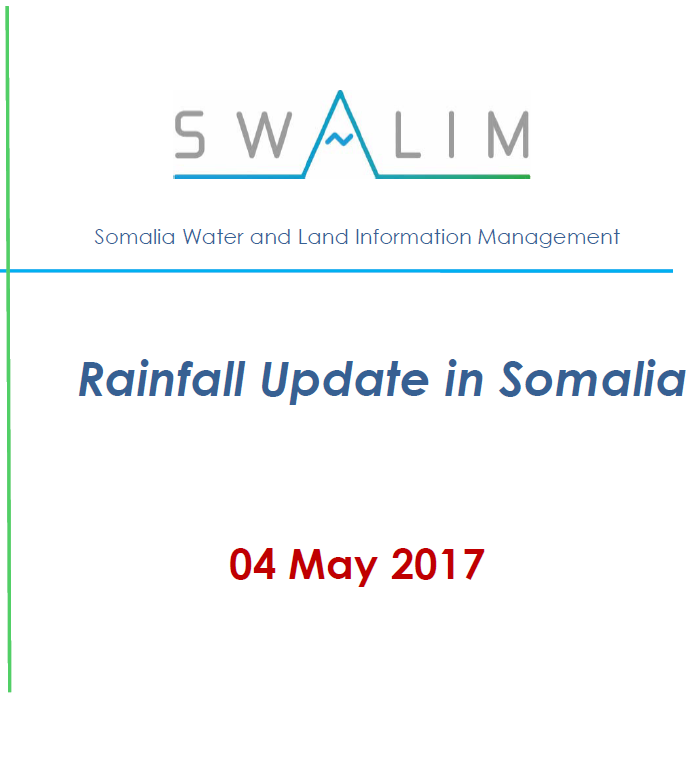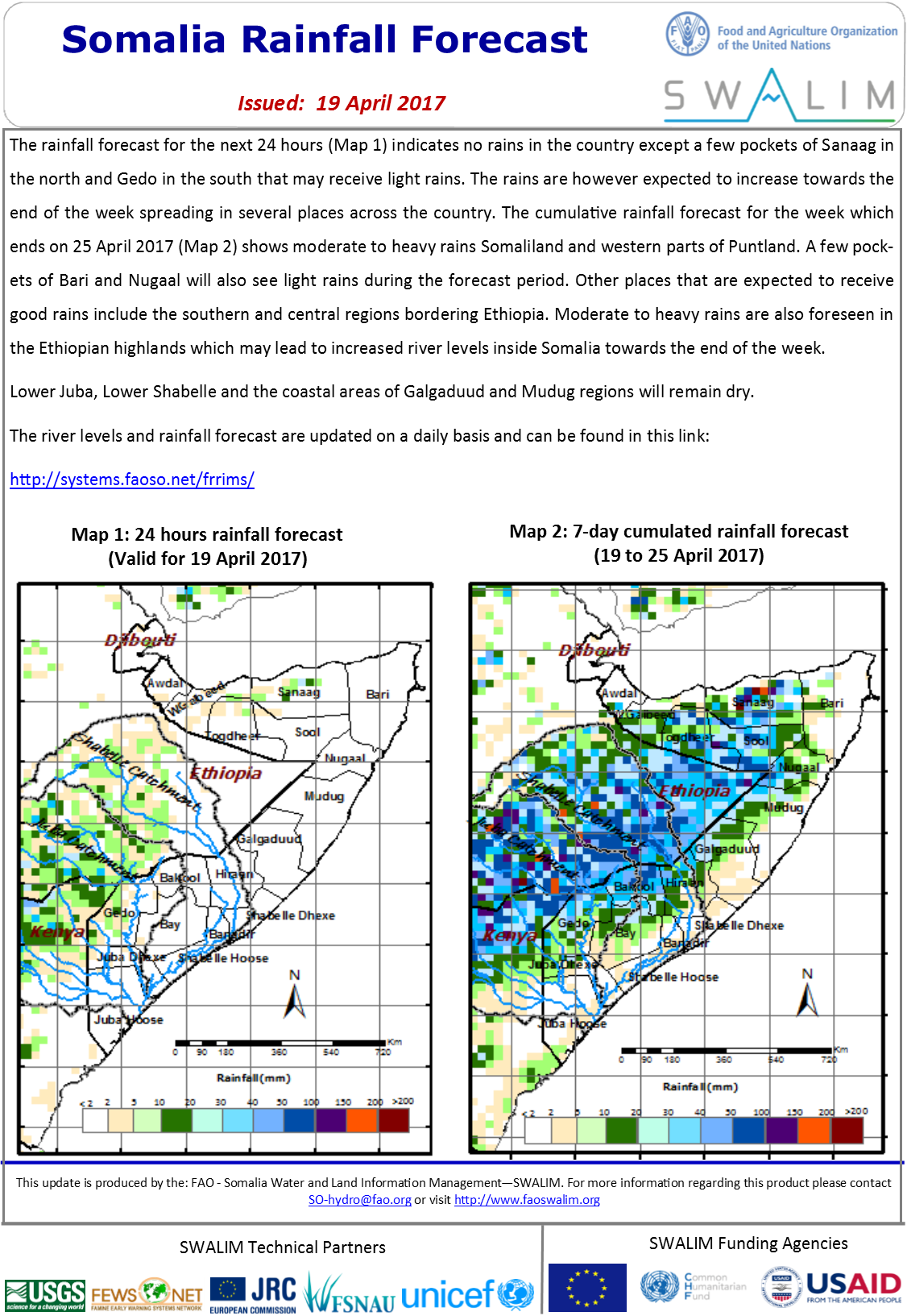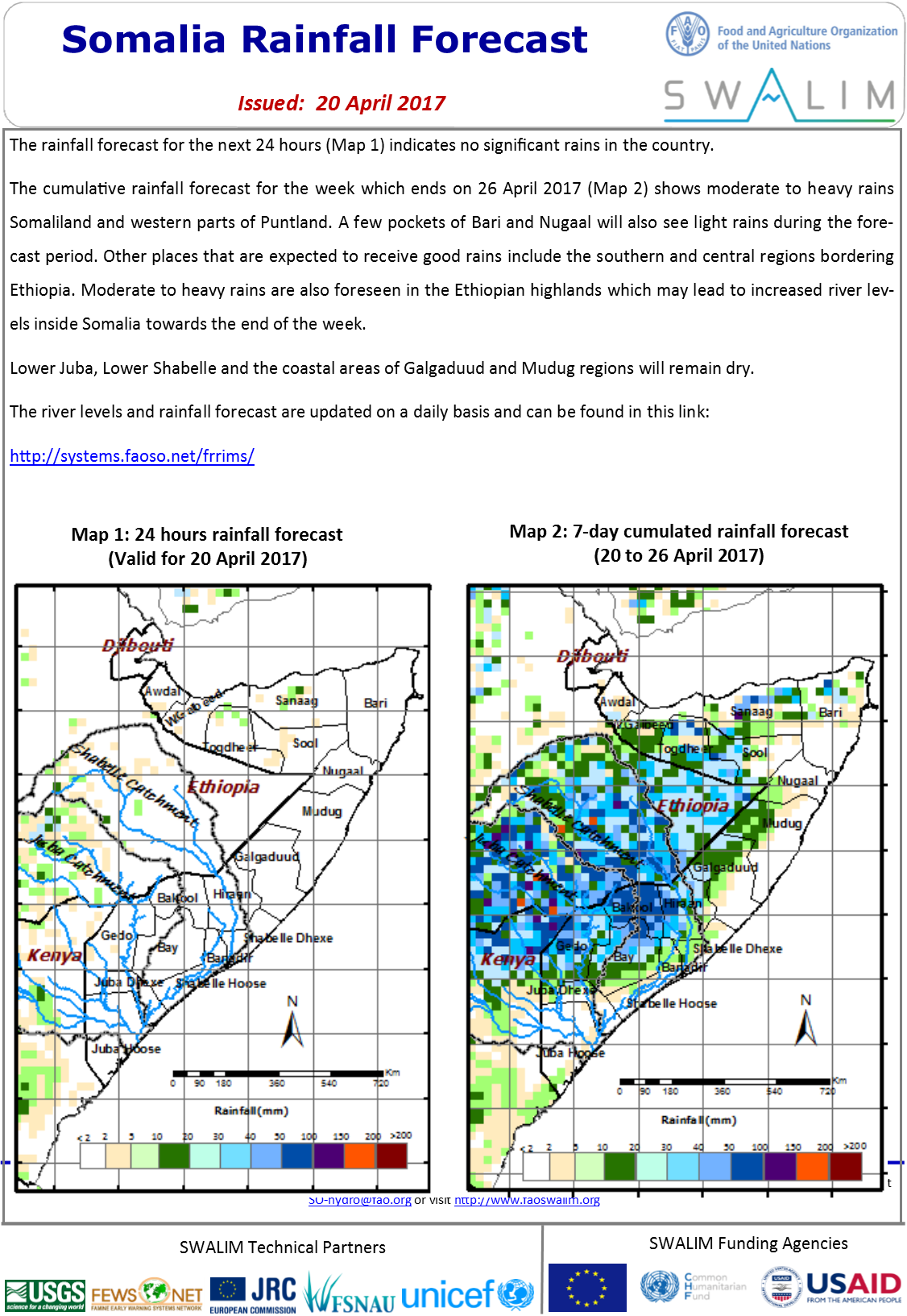Library Catalog
Latest Documents and Publications listed. Use search terms in the box below to find what you need
Somalia Rainfall Update - March to 04 May 2017
The Gu rainy season kicked off in the last week of March in some areas of Somaliland including southern parts of Awdal, Woqooyi Galbeed and Togdheer regions. The March rains were poorly distributed in terms of space and time, but provided an immediate relief to water stressed areas.
The month of April saw a reduction of rainfall activities with most stations recording below normal rains for the month. There was a relief in the last week of April when heavy rains were observed in many areas. A few stations continued to receive rains in the beginning of May especially in Togdheer region.
In general, despite the good short lived rains, the amounts so far received in Somaliland are below average and not adequate to support the current water stress in the area. More rains with good distribution are required to end water scarcity.
The Forecast for the coming two weeks calls for continued rains in the area especially in Woqooyi Galbeed and Togdheer regions.
River levels along the two rivers inside Somalia have subsequently been rising since the last two weeks with the rising trend set to continue in the coming weeks.
Publication Type:
Rainfall Performance
Publication Date:
Author:
Corporate Author:
Somalia Rainfall Forecast 17-05-2017
The northern parts of he country and coastal areas in the south will continue to receive rains in the next three days.
The rainfall forecast for the coming week is pointing towards moderate to heavy rains in the basins both in the Ethiopian highlands and inside Somalia.
Many areas in Puntland and Somaliland will also continue to receive rains during this period
Publication Type:
Rainfall Forecast
Publication Date:
Author:
Corporate Author:
Somalia Rainfall Forecast 09-05-2017
Light to moderate rains continued to be received in a few places across the country in the last two days. The rains are expected to continue in most parts of the country in the next seven days. The rainfall forecast for the coming week (Map 2), indicates moderate to heavy rains in Somaliland and Puntland. Light to moderate rains are foreseen in the southern parts while central regions are expected to remain dry during the same period.
The Ethiopian highlands are also expected to continue receiving rains during the same period. This is will turn lead to a further increase in river levels along the Juba and Shabelle Rivers. Riverine flooding has been reported in Middle reaches of the Shabelle River due to existing open river banks and weak river embankments. There remains a moderate risk of flooding in middle and lower reaches of Shabelle. No risk of flooding is foreseen along the Juba.
Users are advised that this is a forecast and at times there may be discrepancies between forecast and actual amounts of rainfall received.
Publication Type:
Publication Date:
Author:
Corporate Author:
Somalia Flood Watch Bulletin 19-05-2017
The northern parts of he country and coastal areas in the south will continue to receive light rains in the next three days.
The rainfall forecast for the coming week is pointing towards heavy rains in Nugaal, South of Sool and north of Mudug regions. Other regions in the north will receive light to moderate rains. The upper parts of Ethiopian highlands and southern coastal areas of Somalia are expected to receive moderate rains. Little or no rains are expected in central and inland southern regions of the country during the forecast period.
Publication Type:
Rainfall Forecast
Publication Date:
Author:
Corporate Author:
Saadaasha Roob-da’idda Soomaaliya 09-05-2017
Labadii maalmood oo u dambeeyey ayaa waxaa sii socday roobab fudud ilaa kuwo dhexdhexaad ah oo ka da’ay dhawr meelood oo dalka ku kala yaal. Roobabka waxaa la filayaa in ay toddobada maalin ee na soo xiga ka sii socdaan gudaha qaybo badan oo dalka ka tirsan. Saadaasha roob da’idda ee toddobaadka soo aadan (Khariirad 2), waxay muujineysaa in roobab dhexdhexaad ah ilaa kuwo culus ay ka jiri doona gudaha Soomaaliland iyo Puntland.
Waxaa gudaha qaybaha koonfureed laga filayaa roobab fudud ilaa kuwo dhexdhexaad ah halka gobollada dhexe la filayo in ay isla muddadaas ahaadaan qalayl. Buuraleyda sare Itoobiya ayaa sidoo kale iyagana la filayaa inay sii ka socdaan roobabka da’aya isla muddadaas inta lagu jiro. Tani ayaa markeeda horseedi doonta inay sii kordhaan heerarka biyaha gudaha webiyada Juba iyo Shabeelle. Fatahaado webi ayaa laga soo sheegay aagga bartamaha webi Shabeelle taas oo ay ugu wacan tahay dacallo furan iyo gebiyada oo tag daran. Weli waxaa halkaas ka jira halis fatahaad dhexdhexaad ah qaybaha dhexe iyo xagga hoose ee webiga Shabeelle. Ma jirto wax halis fatahaad ah oo laga filayo jiidda webi Juba.
Isticmaaleyaash xogtaan waxaa loo sheegayaa inay waxaani yihiin saadaal oo ay dhici karto in mararka qaar ay wax isweydaartaan saadaasha iyo xaqiiqda qadarka roobka la helay.
Publication Type:
Rainfall Forecast
Publication Date:
Author:
Corporate Author:
Somalia Rainfall Forecast 02-05-2017
Rainfall activities intensified in many parts of the country over the last three days. Flash floods were reported in some places including Bari, Nugaal, Mudug and Bay regions following the heavy rains. Most stations in these regions recorded over 50mm in the three days with Baidao station recording 100mm on 30 April 2017.
The rains are expected to continue in most parts of the country in the next seven days but with less magnitude. The Ethiopian highlands are also expected to continue receiving rains during the same period. This is will turn lead to increased river levels along the Juba and Shabelle Rivers. There is no risk of flooding along the rivers during the forecast period.
Users are advised that this is a forecast and at times there may be discrepancies between forecast and actual amounts of rainfall received.
Publication Type:
Rainfall Forecast
Publication Date:
Author:
Corporate Author:
Somalia Rainfall Forecast 10-04-2017
The week ending 09 April 2017 saw moderate rains in parts of Somaliland and southern regions in Somalia. No significant rains were reported in Puntland.
The Ethiopian highland also received good rains that led to a sharp increase in river levels inside Somalia and consequently restoring the river flow in the lower reaches which had gone dry since the beginning of the year.
The rainfall forecast for the next 24 hours (Map 1) indicates little or no rains in the country. The cumulative rainfall forecast for the week which ends on 16 April 2017 shows light to moderate rains in few pockets of Somaliland, Bay and Bakool with little or no rains in other regions (Map 2).
Publication Type:
Rainfall Forecast
Publication Date:
Author:
Corporate Author:
Somalia Rainfall Forecast 19-04-2017
The rainfall forecast for the next 24 hours (Map 1) indicates no rains in the country except a few pockets of Sanaag in the north and Gedo in the south that may receive light rains. The rains are however expected to increase towards the end of the week spreading in several places across the country.
The cumulative rainfall forecast for the week which ends on 25 April 2017 (Map 2) shows moderate to heavy rains Somaliland and western parts of Puntland. A few pockets of Bari and Nugaal will also see light rains during the forecast period. Other places that are expected to receive good rains include the southern and central regions bordering Ethiopia. Moderate to heavy rains are also foreseen in the Ethiopian highlands which may lead to increased river levels inside Somalia towards the end of the week.
Lower Juba, Lower Shabelle and the coastal areas of Galgaduud and Mudug regions will remain dry.
Publication Type:
Flood watch bulletin
Publication Date:
Author:
Corporate Author:
Somalia Rainfall Forecast 04-04-2017
The Gu 2017 rainy season started in parts of Somaliland during the last week of March. Many stations in the region recorded moderate rains while southern parts of Awdal region recorded heavy rains that were distributed within five days. This brought an immediate relief to the area which has been experiencing a prolonged dry period like the rest of the country. More rains are expected in April and May.
The rains are yet to start in many other areas of the country, including Puntland and southern regions. The rainfall forecast for today (Map 1) indicates no significant rainfall amounts but the rains are expected to intensify with the time and space during the week ending on 10th April, 2017 as seen in Map 2. The Cumulated rainfall forecast for the week is pointing towards moderate to heavy rains in the southern regions and the Ethiopian highland (20 to 100mm).
Light to moderate rains of up to 40mm is expected in Somaliland while Puntland and central regions will remain dry.
Publication Type:
Rainfall Forecast
Publication Date:
Author:
Corporate Author:
Somalia Rainfall Forecast 20-04-2017
The rainfall forecast for the next 24 hours indicates no significant rains in the country.
The cumulative rainfall forecast for the week which ends on 26 April 2017 shows moderate to heavy rains Somaliland and western parts of Puntland. A few pockets of Bari and Nugaal will also see light rains during the forecast period. Other places that are expected to receive good rains include the southern and central regions bordering Ethiopia. Moderate to heavy rains are also foreseen in the Ethiopian highlands which may lead to increased river levels inside Somalia towards the end of the week.
Lower Juba, Lower Shabelle and the coastal areas of Galgaduud and Mudug regions will remain dry.
Publication Type:
Rainfall Forecast
Publication Date:
Author:
Corporate Author:
Pages
 RSS feed [compliant with the Agris AP] |
RSS feed [compliant with the Agris AP] |  Agris AP XML
Agris AP XML










